
Concept explainers
You are building additional storage space in your garage. You decide to suspend a 10.0-kg sheet of plywood of dimensions 0.600 m wide by 2.25 m long from the ceiling. The plywood will be held in a horizontal orientation by four light vertical chains attached to the plywood at its corners and mounted to the ceiling. After you complete the job of suspending the plywood from the ceiling, you choose three cubic boxes to place on the shelf. Each box is 0.750 m on a side. Box 1 has a mass of 50.0 kg, box 2 has a mass of 100 kg, and box 3 has a mass of 125 kg. The mass of each box is uniformly distributed within the box and each box is centered on the front-to-back width of the shelf. Unbeknownst to you, one of the chains on the right-hand end of your shelf is defective and will break if subjected to a force of more than 700 N. There are six possible arrangements of the three boxes on the shelf, for example, from left to right, Box 1, Box 2, Box 3, and Box 1, Box 3, Box, 2, and four more. Which arrangements are safe (that is, the defective chain will not break if the boxes are arranged in this way), and which arrangements are dangerous?
The arrangement of the boxes that are safe and the arrangement of the boxes that are dangerous.
Answer to Problem 1P
The arrangement of the boxes that are safe are
Explanation of Solution
Given info: The mass of the sheet of the plywood is
The chains are all hinged at the center only so the angle made by the chain with the plywood is
The free body diagram of the arrangement
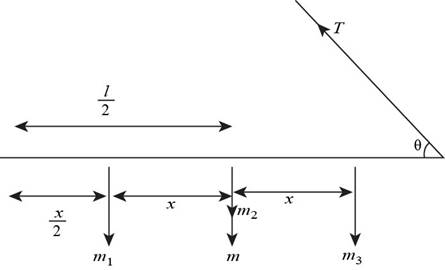
Figure (1)
Take the moment in the above diagram on the left end.
Here,
Substitute
So the tension in each chain in arrangement
The free body diagram of the arrangement
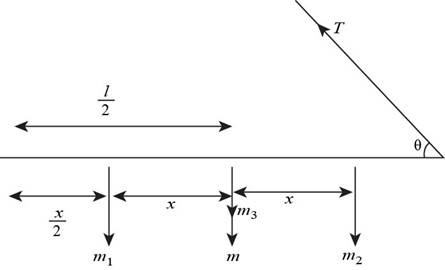
Figure (2)
Take the moment in the above diagram on the left end.
Substitute
So the tension in each chain in arrangement
The free body diagram of the arrangement
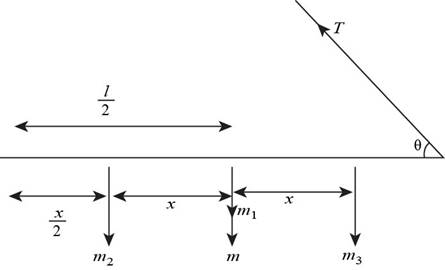
Figure (3)
Take the moment in the above diagram on the left end.
Substitute
So the tension in each chain in arrangement
The free body diagram of the arrangement
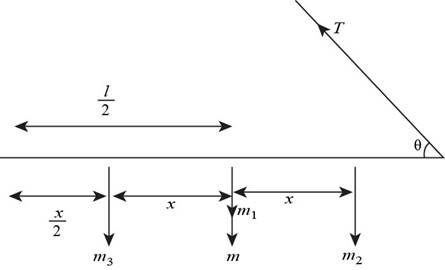
Figure (4)
Take the moment in the above diagram on the left end.
Substitute
So the tension in each chain in arrangement
The free body diagram of the arrangement
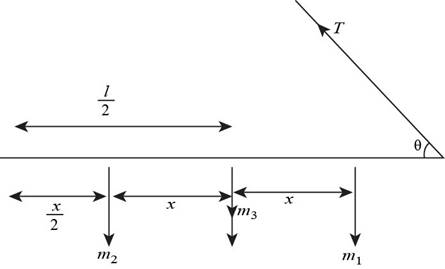
Figure (5)
Take the moment in the above diagram on the left end.
Substitute
So the tension in each chain in arrangement
The free body diagram of the arrangement
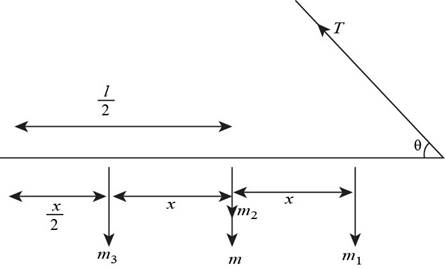
Figure (6)
Take the moment in the above diagram on the left end.
Substitute
So the tension in each chain in arrangement
Conclusion:
Therefore, the arrangement of the boxes that are safe are
Want to see more full solutions like this?
Chapter 12 Solutions
Physics for Scientists and Engineers with Modern Physics
- (a) For a spherical capacitor with inner radius a and outer radius b, we have the following for the capacitance. ab C = k₂(b- a) 0.0695 m 0.145 m (8.99 × 10º N · m²/c²)( [0.145 m- 0.0695 m × 10-11 F = PF IIarrow_forwardA pendulum bob A (0.5 kg) is given an initialspeed of vA = 4 m/s when the chord ishorizontal. It then hits a stationary block B (1kg) which then slides to a maximum distanced before it stops. Determine the value of d.The coefficient of static friction between theblock and the plane is μk = 0.2. The coefficientof restitution between A and B is e = 0.8.Ans: d=1.0034 marrow_forwardFigure 29-43 Problem 12. ••13 In Fig. 29-44, point P₁ is at distance R = 13.1 cm on the perpendicular bisector of a straight wire of length L = 18.0 cm carrying current i = 58.2 mA. (Note that the wire is not long.) What is the magnitude of the magnetic field at P₁ due to i? P2° R R Larrow_forward
- Checkpoint 1 The figure shows the current i in a single-loop circuit with a battery B and a resistance R (and wires of neg- ligible resistance). (a) Should the emf arrow at B be drawn pointing leftward or rightward? At points a, B C R b, and c, rank (b) the magnitude of the current, (c) the electric potential, and (d) the electric potential energy of the charge carriers, greatest first.arrow_forwardPls help ASAParrow_forwardPls help asaparrow_forward
 Physics for Scientists and EngineersPhysicsISBN:9781337553278Author:Raymond A. Serway, John W. JewettPublisher:Cengage Learning
Physics for Scientists and EngineersPhysicsISBN:9781337553278Author:Raymond A. Serway, John W. JewettPublisher:Cengage Learning Physics for Scientists and Engineers with Modern ...PhysicsISBN:9781337553292Author:Raymond A. Serway, John W. JewettPublisher:Cengage Learning
Physics for Scientists and Engineers with Modern ...PhysicsISBN:9781337553292Author:Raymond A. Serway, John W. JewettPublisher:Cengage Learning Physics for Scientists and Engineers: Foundations...PhysicsISBN:9781133939146Author:Katz, Debora M.Publisher:Cengage Learning
Physics for Scientists and Engineers: Foundations...PhysicsISBN:9781133939146Author:Katz, Debora M.Publisher:Cengage Learning Principles of Physics: A Calculus-Based TextPhysicsISBN:9781133104261Author:Raymond A. Serway, John W. JewettPublisher:Cengage Learning
Principles of Physics: A Calculus-Based TextPhysicsISBN:9781133104261Author:Raymond A. Serway, John W. JewettPublisher:Cengage Learning University Physics Volume 1PhysicsISBN:9781938168277Author:William Moebs, Samuel J. Ling, Jeff SannyPublisher:OpenStax - Rice University
University Physics Volume 1PhysicsISBN:9781938168277Author:William Moebs, Samuel J. Ling, Jeff SannyPublisher:OpenStax - Rice University College PhysicsPhysicsISBN:9781938168000Author:Paul Peter Urone, Roger HinrichsPublisher:OpenStax College
College PhysicsPhysicsISBN:9781938168000Author:Paul Peter Urone, Roger HinrichsPublisher:OpenStax College





